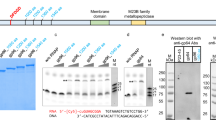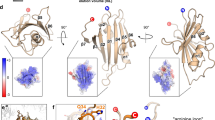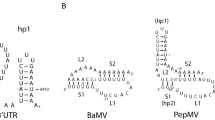Abstract
HIGH mutation rates have driven RNA viruses to shorten their genomes to the minimum possible size1. Mammalian (+)-strand RNA viruses and retroviruses have responded by reducing the number of cis-acting regulatory elements, a constraint that has led to the emergence of the polyprotein2. Poliovirus is a (+)-stranded picornavirus whose polyprotein, encoded by an open reading frame spanning most of the viral RNA3, is processed by virus-encoded proteinases4,5. Despite their genetic austerity, picor-naviruses have retained long 5' untranslated regions6–8, which harbour cis-acting elements that promote initiation of translation independently of the uncapped 5' end of the viral messenger RNA9–12. These elements are termed 'internal ribosomal entry sites'10 and are formed from highly structured RNA segments13–15 of at least 400 nucleotides16. How these elements function is not known, but special RNA-binding proteins may be involved17. The ribosome or its 40S subunit probably binds at or near a YnXm AUG motif (where Y is a pyrimidine and X is a purine) at the 3' border of the internal ribosomal entry site17, which either provides the initiating codon16,18 or enables the ribosome to translocate to one downstream (E.W. et al., submitted). Initiation from most eukary-otic messenger RNAs usually occurs by ribosomal recognition of the 5' and subsequent scanning to the AUG codon19. Here we describe a genetic strategy for the dissection of polyproteins which proves that an internal ribosomal entry site element can initiate translation independently of the 5' end.
This is a preview of subscription content, access via your institution
Access options
Subscribe to this journal
Receive 51 print issues and online access
$199.00 per year
only $3.90 per issue
Buy this article
- Purchase on Springer Link
- Instant access to full article PDF
Prices may be subject to local taxes which are calculated during checkout
Similar content being viewed by others
References
Reanney, D. C. Symp. Soc. gen. Microbiol. 35, 175–196 (1984).
Kräusslich, H.-G. & Wimmer, E. A. Rev. Biochem. 57, 701–754 (1988).
Kitamura, N. et al. Nature 291, 547–553 (1981).
Hellen, C. U. T., Kräusslich, H.-G. & Wimmer, E. Biochemistry 28, 9881–9890 (1989).
Harris, K. S., Hellen, C. U. T. & Wimmer, E. Seminars in Virology Vol. I (ed. Strauss, J. H.) 323–333 (Saunders, Philadelphia, PA, USA, 1990).
Rueckert, R. R. in Virology 2nd edn (eds Fields, B. N. et al.) 507–548 (Raven Press, New York, 1990).
Dorner, A. J., Dorner, L. F., Larsen, G. R., Wimmer, E. & Anderson, C. W. J. Virol. 42, 1017–1028 (1982).
Palmenberg, A. C. in Positive Strand RNA Viruses, UCLA Symposia on Molecular and Cellular Biology Vol. 54 (eds Brinton, M. A. & Rueckert, R. R.) 25–34 (A. R. Liss, New York, 1987).
Jang, S. K. et al. J. Virol. 62, 2636–2643 (1988).
Jang, S. K., Davis, M. V., Kaufman, R. J. & Wimmer, E. J. Virol. 63, 1615–1660 (1989).
Pelletier, J. & Sonenberg, N. Nature 334, 320–325 (1988).
Pelletier, J. & Sonenberg, N. J. Virol. 63, 441–444 (1989).
Pilipenko, E. V. et al. Virology 168, 201–209 (1989).
Pilipenko, E. V., Blinov, V. M., Chernov, B. K., Dmitrieva, T. M. & Agol, V. I. Nucleic Acids Res. 17, 5701–5711 (1989).
Skinner, M. A. et al. J. molec. Bid. 207, 379–392 (1989).
Jang, S. K. & Wimmer, E. Genes Dev. 4, 1560–1572 (1990).
Jang, S. K., Pestova, T., Hellen, C. U. T., Witherell, G. W. & Wimmer, E. Enzyme 44, 292–309 (1990).
Kaminski, A., Howell, M. T. & Jackson, R. J. EMBO J. 9, 3753–3759 (1990).
Kozak, M. J. Cell Biol. 108, 229–241 (1989).
Hellen, C. U. T., Fäcke, M., Kräusslich, H.-G., Lee, C.-K. & Wimmer, E. J. Virol. 65, 4226–4231 (1991).
Nicklin, M. J. H., Kräusslich, H.-G., Toyoda, H., Dunn, J. J. & Wimmer, E. Proc. natn. Acad. Sci. U.S.A. 84, 4002–4006 (1987).
Van der Werf, S., Bradley, J., Wimmer, E., Studier, F. W. & Dunn, J. J. Proc. natn. Acad. Sci. U.S.A. 83, 2330–2334 (1986).
Molla, A., Paul, A. V. & Wimmer, E. Science 254, 1647–1651 (1991).
Kräusslich, H.-G., Nicklin, M. J. H., Toyoda, H., Etchison, D. & Wimmer, E. J. Virol. 61, 2711–2718 (1987).
Davis, B. D., Dulbecco, R., Eisen, H. N. & Ginsberg, H. S. in Microbiology 3rd edn 874–883 (Harper and Row, New York, 1980).
Argos, P., Kramer, G., Nicklin, M. J. H. & Wimmer, E. Nucleic Acids Res. 12, 7251–7267 (1984).
Sonenberg, N. Curr. Top. Microbiol. Immun. 161, 23–47 (1990).
Macejak, D. C. & Sarnow, P. Nature 353, 90–94 (1991).
Pincus, S. E., Diamond, D. C., Emini, E. A. & Wimmer, E. J. Virol. 57, 638–646 (1986).
Author information
Authors and Affiliations
Rights and permissions
About this article
Cite this article
Molla, A., Key Jang, S., Paul, A. et al. Cardioviral internal ribosomal entry site is functional in a genetically engineered dicistronic poliovirus. Nature 356, 255–257 (1992). https://doi.org/10.1038/356255a0
Received:
Accepted:
Issue Date:
DOI: https://doi.org/10.1038/356255a0
This article is cited by
-
A Novel Recombinant Enterovirus Type EV-A89 with Low Epidemic Strength in Xinjiang, China
Scientific Reports (2015)
-
Complete Genome Characterization of a Novel Enterovirus Type EV-B106 Isolated in China, 2012
Scientific Reports (2014)
-
Genomic characterization of an enterovirus 97 strain isolated in Shandong, China
Virus Genes (2010)
-
Protein-primed RNA synthesis by purified poliovirus RNA polymerase
Nature (1998)
Comments
By submitting a comment you agree to abide by our Terms and Community Guidelines. If you find something abusive or that does not comply with our terms or guidelines please flag it as inappropriate.



